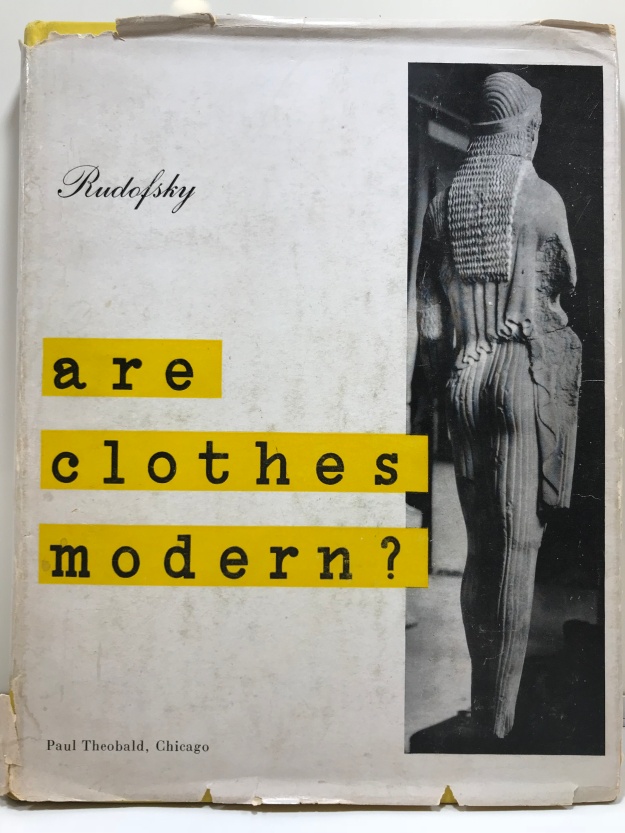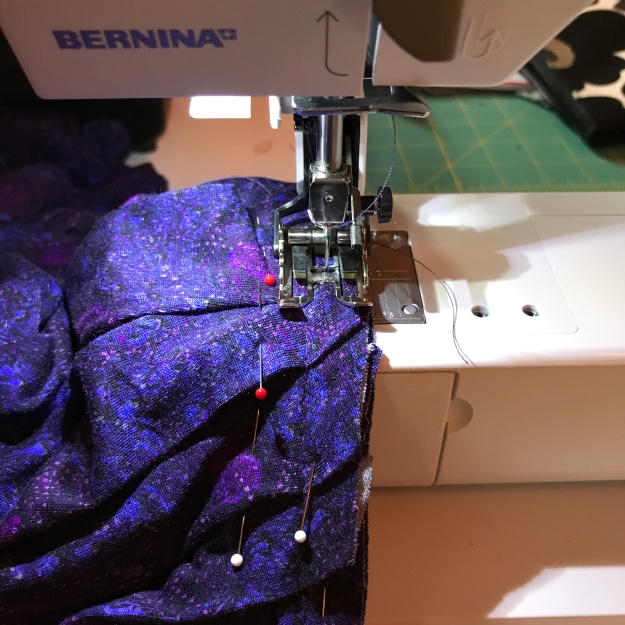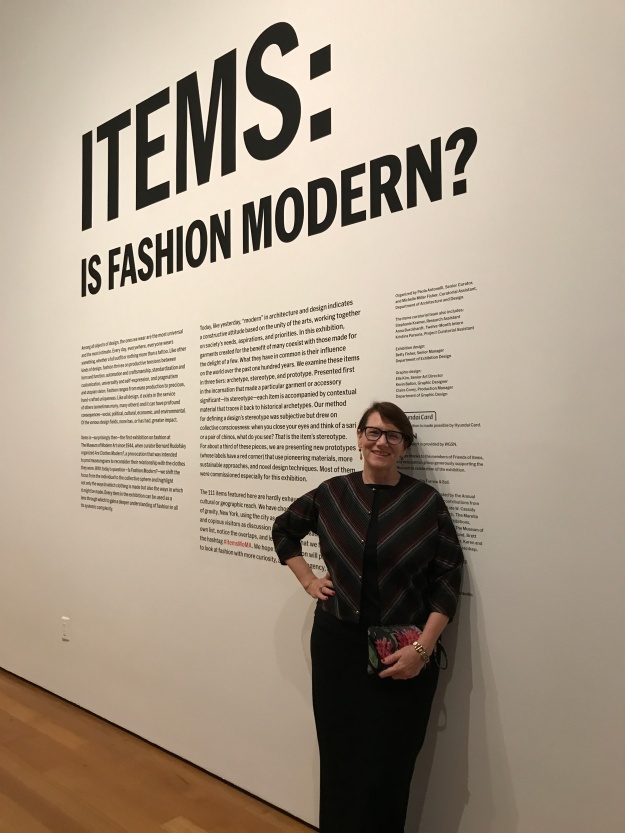So I needed an outfit to wear to the opening night party of the Museum of Modern Art’s Items: Is Fashion Modern exhibit – their first show about fashion since the 40s. Through a bit of kismet, the curators had discovered my Claire McCardell research via my blog, and contacted me. I helped them locate a rare pair of McCardell’s original ballet flats, answered a lot of questions, and loaned them a photo from my collection for their exhibit and catalogue. In case you missed it, they put the tale of my unusual path to becoming a fashion historian on their blog.

The exhibit, which tells the story behind 111 iconic wardrobe items, was inspired by MoMA’s original 1940s exhibit “Are Clothes Modern,” in which McCardell’s designs were featured for their architectural quality. Here are some of her fashions from the museum catalogue, with completely inaccurate patterns! (Obviously not from McCardell’s team.)

Claire also consulted on another textile exhibit at what was then referred to as “The Modern” in the 50s. So I knew I had to bring a bit of her spirit with me to the party.
And whatever I was making, it had to go with ballet flats.
Concept #1: The McCardell pintucked dress:
During the 40s and particularly the 50s, McCardell used clever tucks that often would release at the bust and hip, to give the dresses a design element without a lot of frou frou. Lots of times she would use striped fabrics, and pull together the stripes with the tucks to give the bodice a solid color that would open at the bust to give a peek of the stripes – drawing the eye to the bust. (Even though McCardell was known for practical designs, they always had a hint of sex.)
Here’s an example from the Metropolitan Museum Costume Institute’s excellent collection of McCardell garments:

Oo, I was going to look like this!

(After I had liposuction and a rib removed, which some women, including designer Jo Copeland, actually did back then to get a wasp waist.)
I have several of McCardell’s Spadea patterns that have tucks like these, so I decided to try this sheath pattern, using a striped seersucker that would show the manipulation of the fabric. I figured I’d give it a test run, and if I liked it, make it from fancier fabric.

Since my Bernina, Karl, (who recently went from intern to “work husband” when I bought him) was off at the machine spa, I put his Walking Foot #50 on Coco the B 215 (on loan in a pinch – thank you BERNINA!) and got moving. She was more than up for the job.

I started making tuck – after tuck – after tuck – lining each one up so that the stripes came together evenly. The directions called for each tuck to be topstitched 1/4″ from the edge, so they would open over the bust like an accordion. Then a side dart was elegantly added at the edge, so the shape of the dress wasn’t too boxy.

Days of tucks later – when I started to ruminate about how the word “painstaking” is a combo of “pains” and “taking” – I realized that I was probably once again making – let’s call it an homage – to my previous bombs that I refer to as “Gertrude Stein’s Bathrobe” and “Bea Arthur’s Spa Robe.”

I think this design will actually work as summer duster, but not as an avant garde party dress. When the collar piece didn’t line up and needed recutting, I abandoned it (for now) for another project.
Concept #2: The McCardell Jersey Wrap Dress:
I had done a ponte version of this 1958 McCalls pattern that hadn’t worked for me – the ponte was too heavy, and in the gray it gave me that “air de la prison matron” look.

I’ve found that most McCardell garments are made from lightweight fabric, so this time I tried it using very light Liberty Dufour viscose jersey (the original pattern called for wool jersey). There were a lot of tricky uneven tucks at the top of the shoulder, but the walking foot made quick work of them.

So far so good, but I found that the bodice was out of balance, with too much weight in the front tucks, which is probably why the pattern calls for a giant belt to support it. I often wonder about these late 50s patterns attributed to McCardell, “designed exclusively for McCalls,” which were released when she was very ill from cancer, or after her death. She was so weak that her lifelong friend and fellow designer, Mildred Orrick, used to come to the hospital to sketch her designs. Compared to the Spadea patterns, which were drafted in the early 50s from original retail garments, the McCalls seem a bit dumbed down, and probably not tested by McCardell’s sample makers, just sketched up and sent to McCalls.

I was frustrated that the shoulder seam kept slipping forward due to the weight of the tucks in front. Looking at this photo of McCardell in a similar design, (which is actually a jacket, also in the Met’s collection) I noticed that to hold the tucks up, the neck needed to be high in the back, unlike the McCalls pattern, which dips in a “V” behind the back.
So I did a “hail Mary,” pulled the neckline up in the back, made a number of other modifications to the bodice, and that put it back in balance.
I didn’t want the gathers of the skirt to make me look too big in the hips this time, and in fact, McCardell often moved gathers in her skirts to different places for different bodies. Sometimes they were centered over the hips for people who are shaped like rulers, and sometimes they were centered over the rear and stomach to streamline the hips. So I moved the gathers to the center front and back, and put the side seams with pockets slightly forward, as she would move the pockets around as well.
Instead of wearing a belt, which I loathe at this age, I added a 3″ ring of knit elastic inside at the waistband. It’s like Spanx! I recommend it to support knit dresses at the hips. Since modern jersey and knit elastic are so much stretchier than wool jersey and stiff elastic from the 50s, I was able to skip the side zipper.

After all of this monkeying around, I had significantly modified the design and made it much closer to an authentic McCardell look from that era. I threw together the rest of the dress in the nick of time to put it in the Martha’s Vineyard Fair! (Lovely hair from sewing in 90% humidity…)

Second place due to wonky seam finishes. Oo, those judges are tough!

But I did win a blue ribbon for my hack of the Vogue 8930 sweater coat. Then I caught a couple of women manhandling it when I was stalking – er photographing – my makes.
Hands off the silk crepe de chine woman! Sheesh!

I really like this dress, but it feels more like one of McCardell’s Kitchen Dinner “entertaining at home” looks. You know, for Thanksgiving dinner with the fam. But to wear to a fashion party at Museum of Modern Art? It just wasn’t modernist enough. Which led to:
Concept #3: The Houndstooth McCardelligan:
I’ve made three McCardell cardigan jackets before – two from knits and one from lined tweed – and I love them all. They’re hacked from a couple of original McCardell jackets in my collection, and have the style elements she used again and again: cut-in kimono sleeves, a bias cut chevron, and a large French dart for waist and bust shaping. During her career, she designed dozens of variations of this jacket, sometimes with collars, kerchief points in the back, piping, or pockets.

I decided that one of these jackets would be more representative of McCardell’s architectural style for the MoMA party, and got going with some haute couture linen houndstooth from Paris. I figured it was the right weight for late September in New York.

I carefully lined up, pinned, and cut the fabric, which is very loosely woven and could slide around on the bias. I hand thread-traced around the seamline, as that keeps you out of trouble when sewing bias seams, which can stretch all over the place. (To learn about bias sewing, I recommend Sandra Betzina’s course “Sewing on the Bias” on craftsy.com.)

All cut and ready to go! I had a month to finish! Then waves of extended family showed up at the end of the summer, and well…
Concept #4: The Donna Karan Skirt:
I started thinking that the houndstooth might be a little loud for a McCardell jacket. Also, I saw the list of items featured in the Museum of Modern Art’s show, and one classic element was comprised of Donna Karan’s “Seven Easy Pieces,” which I certainly wore in the 80s. They included a bodysuit, jacket, soft pants, shawl, wrap skirt, belt etc. that all went together for work and travel.
McCardell had come up with a set of similar separates in the 30s, but the retailers refused buy her “Six Black Matches” until a few years later, because the idea of a “capsule wardrobe” was too radical for that era. These 1934 separates of McCardell’s, in the Met’s collection, were probably items from her personal wardrobe that she took to France twice a year for the fashion shows.
That sent me down a rabbit hole that resulted in getting an “Easy” Donna Karan 80s Vogue pattern from her original Seven Easy Pieces collections, to make a skirt that was an homage to McCardell’s Six Black Matches. I decided to extend it into a maxi.
Easy, huh?!




OMG Ode on a Grecian Urn meets the draperies! Abandon the S.S. Donna Karan!
Concept #5: McCardelligan from Menswear:
When I got back home in the fall, the clock was really ticking to finish my outfit. As I was unpacking my sewing stash and shoving it in an overhead closet, I discovered a cache of vintage Savile Row fabric I’d found for a song three years ago on Etsy, and had completely forgotten about!!!
I had four yards of gorgeous 50s men’s suiting wool from legendary Wains and Shiell that was screaming McCardell’s name. She famously used menswear fabrics to create evening dresses with jackets that were chic, warm, and feminine in their way.
My inspiration was a photo by Louise Dahl-Wolfe, whose color-saturated modernist images put Harper’s Bazaar (then under the helm of fashion editor Diana Vreeland) on the map in the 40s. (If you’re in London, check out the Dahl-Wolfe exhibit at the Fashion and Textile Museum this fall.)

(Looking at Matisse, Museum of Modern Art, 1939)
I thought that a jacket with long skirt would be just the ticket, but skip the feathers.
I cut another McCardell cardigan jacket, each piece in a single layer, and matched them all at the center front and shoulder line. I would cut one piece, keep it pinned to the pattern, flip it over, and match the stripes for the mirror-image piece, which makes a chevron in the front and back. The chevron keeps the bias from twisting, and gives the jacket a geometric look.

So much matchy-matchy! I used a lot of pins, because sticking the pin through both layers right at the seamline is the way to go.

(I cheated and thread-traced by machine – then modified the fit – as you can see by the chalk line.)

My brain hurt after all of that matching! The walking foot really helped keep the layers of fabric even over the feed dogs, so the stripes lined up properly.
I totally cheated and finished the seam allowances by gluing the edges with Steam-a-Seam Lite – no time left for binding this unlined jacket!

Of course, it wouldn’t be a McCardell without topstitching. She was inspired by a topstitched French worker’s hat in the 30s, and added the detail as a jaunty fashion element to her womenswear – even for evening.

Eep – tacking down the facing on the train to New York!

Five vintage brass shoe buttons sewn on between Providence and Mystic:

Phew! Finished in the nick of time! And after all that, it was just what I had in mind.

Even though it was hot and humid, this light, breathable wool was soft, comfortable, and wrinkle-free. McCardell really was onto something making all-season eveningwear from men’s fabric.
Let’s go to the party!
I was accompanied by Janet, Jet Set Sewing’s trusty New York City bureau chief and location photographer (AKA my sister). We’ve been hitting the town together for more that 30 years, probably making us the city’s oldest Holly Golightlys. Even though she and most of Manhattan had been delayed in traffic for two hours while our president, in one of those “let them eat cake” moments, had dinner at Le Cirque, she was still game to go.
The Museum of Modern Art was packed – seven deep at the bar and people spilling out into the garden! We walked in, looked around, and said, “guess we’re not going to find those people we were looking for.”

But what an exhibit!

It had a little of everything – Chanel’s original Little Black Dress from the 20s:

Diane Von Furstenberg’s wrap dress:

Donna Karan’s Seven Easy Pieces (these are few of them):

A fanciful harem look from the early 20th century by Paul Poiret:

A hoodie hung like a piece of sculpture:

Polo shirts, platform shoes, shift dresses:

Even a Wonderbra, tighty-whities – and Spanx. With cellulite! (Little did people know that my behind looked just like that.)

But where were those ballet flats?
Ah, at long last I got to see them in person.

These are from 1943, when WWII rationing kept women from buying many new shoes. Since dance shoes were not on the rationing list, McCardell enlisted the Capezio company to make ballet slippers from fabric that matched her outfits – with soles that covered the entire bottom of the slipper, so they could be worn on the street. (The soles of stage ballet slippers only cover some of the bottom of the foot, and wear out easily on pavement.)
I looked below the ballet flats and saw the photo from my collection – with my name next to it! EEEEEEEEEEEEEEEEEE!!!

(Although it’s actually not a publicity still from a film – it’s a 1943 press photo publicizing McCardell’s collection. I’m not sure how that mixup happened, but hey, they got my name spelled right!)

Just casually lounging nearby so I can point out my name to people…
It’s a great exhibit! Here’s a review from the New York Times.
On the way back to my sister’s, strolling the avenues of Manhattan’s East Side on that balmy September evening, I really did feel like I’d gone back in time – when a long skirt, a little McCardell jacket, and simple ballet flats were all a girl needed for a glamorous night out at The Modern.